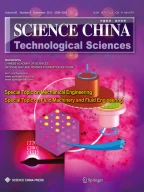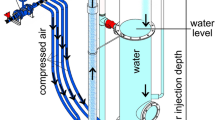Numerical and experimental investigations for an air cannon optimization

Air cannon is a kind of de-clogging device which produces impulse force by instantly releasing the compressed air deposited in a pressure vessel. Air cannons are widely used in the transport pipes of warehouses, docks, furnaces and coal mines. In this paper, the theoretical analysis with isentropic flow hypothesis is firstly conducted on a simplified model to deduce the theoretical maximum of impulse force. And numerical study is carried out to predict the steady and unsteady impulse forces via simulating the whole exhausting process of the air cannon. The results demonstrate that the impulse force can be improved via increasing the piston sleeve inlet length and increasing the nozzle diameter. Laval nozzle can also increase the impulse force of the air without increasing the air mass flow. The optimization of the air cannon is then conducted on the basis of the theoretical and numerical analyses. Experimental measurements indicate that the computations well simulate the working process of the air cannon and the impulse force of the optimized design is 50% higher than the original model. For the cases with working pressure of 0.8 MPa, the optimized design is 60% higher than the original one.
This is a preview of subscription content, log in via an institution to check access.
Access this article
Subscribe and save
Springer+ Basic
€32.70 /Month
- Get 10 units per month
- Download Article/Chapter or eBook
- 1 Unit = 1 Article or 1 Chapter
- Cancel anytime
Buy Now
Price includes VAT (France)
Instant access to the full article PDF.
Rent this article via DeepDyve
Similar content being viewed by others

A preliminary investigation of the design parameters of an air induction nozzle
Article 01 July 2017

Research on the Air Conditioning Terminal Unit Performance of Novel Heat and Humidity Treatment
Chapter © 2023

Experimental Evaluation of Airlift Performance for Vertical Pumping of Water in Underground Mines
Article Open access 14 August 2021
References
- Wright H, Weare F E, Swinderman R T. Preliminary investigation into the effects of air cannon discharge on steel and concrete structures. In: Proceedings of the Technical Program-International Powder and Bulk Solids Handling and Processing. Rosemont: Int Powder Inst, 1984 Google Scholar
- Jia W T, Pan W F. The application research of air cannon in transient shock excitation test. Res Briefing, 1991, 10(1):26–30 Google Scholar
- Lou D C, Lv P M. Two attention about free jet flow computation. J Eng Thermophys, 2005, 26(Supp):53–56 Google Scholar
- Lv P M. The influence investigation about boundary condition to radial turbulent jet flow computation. J Eng Thermophys, 2002, 23(1):43–46 Google Scholar
- Lv P M. The influence of nozzle outlet initial turbulent structure to free jet flow expansion ratio. J Eng Thermophys, 1996, 17(2):184–187 Google Scholar
Author information
Authors and Affiliations
- Institute of Engineering Thermophysics, Chinese Academy of Sciences, Beijing, 100190, China Jian Xu, HaiSheng Chen, ChunQing Tan & HuanZhuo Chen
- Graduate University of Chinese Academy of Sciences, Beijing, 100049, China Jian Xu
- Zhengzhou Eurasia Air Cannon Co. Ltd., Zhengzhou, 450041, China GenSheng Zhou
- Jian Xu



